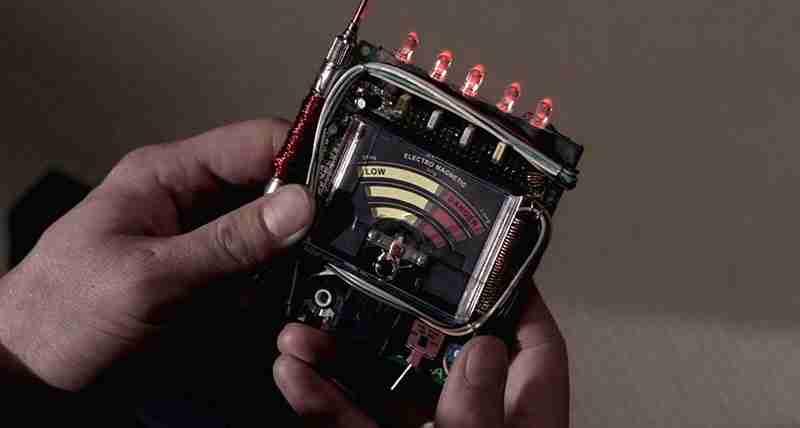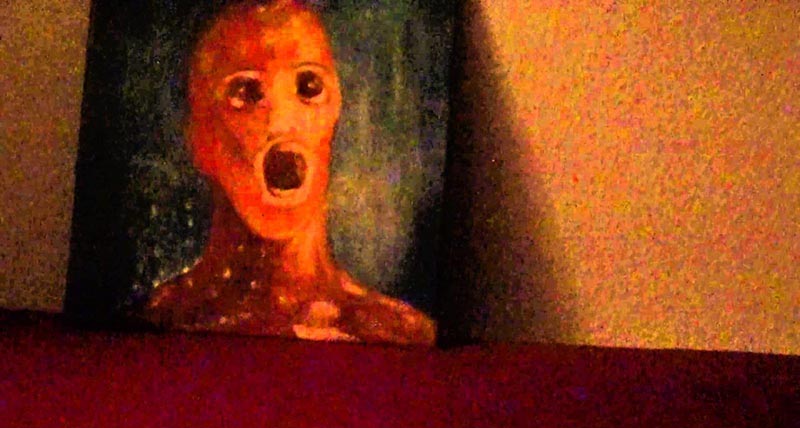EMF readers are essential devices that should be included in any paranormal investigation kit. These detectors come in various types, including analog, digital, and light sensors. Understanding how to interpret the readings from these meters is essential for accurate detection.
Analog meters display readings by moving a needle from zero to a specific point. The higher the reading, the more EMF is present in the environment.
Light sensors operate by illuminating different lights based on the intensity of the detected EMF. No light indicates the absence of EMF, while blue/green and red lights represent low/limited and high levels of EMF, respectively.
Digital meters show a numerical reading that starts at zero and increases as EMF is detected.
Table of Contents
Understanding Electromagnetic Fields
Before diving into EMF meters’ intricacies, let’s establish a solid foundation by understanding electromagnetic fields.
These fields consist of lines of energy that are invisible to the naked eye and are generated by various sources of electricity, ranging from power lines to household appliances.
It’s important to note that outdoor EMF readings can be influenced by environmental factors such as trees, buildings, and vehicles in the vicinity. Therefore, when conducting your investigations, it’s crucial to consider these external elements that may impact your readings.
At the heart of ghost hunting lies the Electromagnetic Field Meter, a device designed to measure fluctuations in electromagnetic fields. These fields are everywhere – around appliances, power lines, and even the Earth itself.
But in the context of ghost hunting, these devices detect anomalies, unusual spikes or drops in the electromagnetic field that cannot be easily explained.
Related: Your Ultimate Guide to Ghost-Hunting Tips, Techniques, and FAQs
The theory behind using EMF detectors in paranormal investigations is based on the belief that ghosts and spirits can manipulate these fields, causing noticeable fluctuations.
When a ghost is present, it is said to emit or influence electromagnetic fields, making an EMF detector a vital tool for any ghost hunter.
But where does ectoplasm come into play?
Ectoplasm, a term coined in the early days of spiritualism, is believed to be a physical substance that spirits can produce or manipulate.
While its existence is disputed, many in the field of paranormal research believe that ectoplasm or a similar energy may be responsible for the electromagnetic disturbances detected during ghost hunts.
If you are new to ghost hunting, How to Start Ghost Hunting: Expert Techniques, Tips, and Tools can help you grasp the basics.
Types of Ghosts and How EMF Detectors Perceive Them
In the spectral world, not all ghosts are created equal. Ghost hunters may encounter several types of apparitions, each with unique characteristics and ways of interacting with the physical world.
Interactive Personalities
Interactive Personalities are the most common type of ghost. These are the spirits of deceased individuals who retain their personalities and emotions from when they were alive.
They can manifest in various ways, such as making noises, emitting odors, or appearing visibly. EMF detectors can pick up on their presence when a sudden spike in the electromagnetic field can’t be attributed to any known source.

Ecto-Mists
Ecto-Mists, also known as ghostly mists, are another type of apparition. They appear as a swirling fog and are often captured in photographs or videos. EMF detectors can detect their presence when there’s a fluctuation in the electromagnetic field that coincides with the appearance of the mist.
Poltergeists
Poltergeists, or “noisy ghosts,” are known for their ability to manipulate the physical environment. They can knock things over, turn lights on and off, and even start fires.
On the same topic: Demon Drummer of Tedworth: The True Story Behind a Powerful 17th Century Poltergeist
When a poltergeist is present, an EMF detector may register a significant increase in electromagnetic activity.
Orb Ghosts
Orb ghosts (or simply “orbs” are believed to be the souls of deceased humans or animals. They appear as transparent or translucent balls of light that hover over the ground. EMF detectors can pick up on their presence when there’s a sudden, localized increase in the electromagnetic field.
Funnel Ghosts
Funnel Ghosts are often associated with paranormal cold spots and appear as a swirling funnel of light. They are most often spotted in homes or old historical buildings. When a funnel ghost is present, an EMF detector may register a drop in the electromagnetic field.
How to Use EMF Ghost Detectors
Using an EMF detector for ghost hunting is both a science and an art. The first step is to calibrate the device. This involves taking a base reading in the area you’re investigating to determine the normal level of electromagnetic activity.
For those just starting out as paranormal investigators, I recommend reading Ghost-Hunting Equipment for Beginners: A Comprehensive Guide for more information on the essential equipment you will need.
However, if you are on a tight budget, How to Make Your Own Ghost Hunting Equipment: Best Tips for Budget Gear provides many amazing starting tips and step-by-step tutorials on how to start ghost hunting on a small budget.
But for now, let’s get back to our tutorial on how to use EMF Ghost Detectors.
Speaking of spikes, any spikes or drops in this base reading could indicate the presence of a ghost.
When using an EMF detector, it’s essential to be aware of potential sources of electromagnetic interference, such as electrical appliances, power lines, and even other team members. This can help in avoiding false positives and ensuring accurate readings.
Interpreting the readings from an EMF detector involves looking for sudden changes in the electromagnetic field.
A sudden spike could indicate the presence of a ghost, especially if it’s accompanied by other signs of paranormal activity, such as cold spots or unexplained noises.
There are many brands of EMF detectors available, but one of the most popular among ghost hunters is the Trifield EMF Meter.
On the same topic: What is a Spirit Box? A Comprehensive Guide
This device is known for its accuracy and ease of use. It can detect changes in the electromagnetic field in all directions, making it an invaluable tool for any paranormal investigation.
When conducting a paranormal investigation, it’s crucial to follow a few simple steps to ensure accurate EMF readings:

Calibration: The First Step to Accurate Measurements
Calibrating your EMF meter is highly recommended to ensure accurate readings before each investigation. Calibration involves using two identical EMF readers to establish a baseline measurement.
Here’s how you can calibrate your meter effectively:
- Turn on both EMF readers.
- Place the first reader on the ground in an area where there is minimal movement of the needle or change in the digital display.
- Position the second reader approximately one foot away from the first one.
- Both readers should ideally display the same readings.
- Repeat this process at various locations to ensure consistent calibration.
Related: Cheap Ghost-Hunting Equipment: Your Guide to Affordable Paranormal Tools and Accessories
You establish a reliable baseline for accurate comparisons during your investigation by calibrating your EMF meter.
Holding the EMF Meter: Best Practices
It is crucial to hold the EMF meter correctly to obtain precise readings.
Follow these best practices to ensure optimal results:
- Hold the meter comfortably at waist level, keeping it upright and slightly out before you.
- Avoid waving, moving, or shaking the meter excessively, as this can lead to inaccurate readings.
- Maintain a steady grip on the meter while conducting your readings.
- Move slowly from place to place, observing and noting any fluctuations in the needle or digital display.
Adhering to these practices minimizes the chances of introducing unnecessary measurement errors.
Baseline Readings: Establishing the Foundation
Before delving into your investigation, it is essential to establish baseline readings of the location you are exploring.
Here’s how you can determine the baseline EMF levels:
- Take readings both inside and outside the target area.
- Look for the lowest and highest EMF readings within the vicinity and calculate the average.
- The resulting average reading serves as your baseline for the site.
During your investigation, whenever you encounter a spike in EMF readings, compare it to the baseline.
A slight increase from the baseline, such as 1.5 to 2.0, may be attributed to natural changes in the electromagnetic field. However, if the spike exceeds 1.5 points or more, it is essential to investigate further to identify the potential cause.
Here’s an essential guide to understanding the spikes:
- 0-1.5 mG: This is considered a normal or “baseline” reading. It’s what you would expect to find in most areas without any significant sources of electromagnetic fields.
- 1.5-2.5 mG: This is a moderate reading. A nearby electrical appliance or power source could cause it. It’s worth investigating further to rule out any mundane sources of EMF.
- 2.5 mG and above: This is a high reading. It could indicate a strong source of EMF or a potential paranormal entity.

Following EMF Spikes: Tracing the Source
EMF spikes can be indicative of both man-made and paranormal phenomena. You can trace their source and gain valuable insights by skillfully following these spikes.
Here’s how you can effectively follow EMF spikes:
- Gradually move your EMF reader up, down, right, left, forward, and backward to identify the area with the strongest signal.
- Once you have identified the region with the strongest signal, investigate potential man-made sources within that area.
- Check the floor from the underside (basement side) if the strongest reading is near the floor. Alternatively, examine the light fixtures on the ceiling if the reading is higher there.
- Document your findings meticulously to create a comprehensive record of your investigation.
By diligently following EMF spikes and investigating their sources, you enhance your ability to differentiate between natural and potentially paranormal occurrences.
Analyzing EMF Data: A Critical Approach
After gathering significant data during your investigation, it is essential to analyze and interpret it critically. Adopting a methodical approach allows you to discern patterns and eliminate false positives.
You may also like: The Brown Lady of Raynham Hall: The True Story Behind the Famous Ghost on the Staircase Photograph
Here’s how you can critically analyze your EMF data:
- Eliminate obvious sources of electromagnetic fields that can be attributed to man-made or natural occurrences.
- Identify areas that appear suspicious or warrant further investigation based on the readings.
- Once you have narrowed down the possibilities, consider employing other paranormal investigation techniques or attempting to establish contact with potential entities.
Frequently Asked Questions About EMF Ghost Detectors
Why Does a Ghost Hunter Use an EMF Detector?
Ghost hunters use EMF detectors to measure fluctuations in electromagnetic fields, which are believed to indicate the presence of ghosts.
How to calibrate your EMF detector?
Calibrating an EMF detector involves taking a base reading in the area you’re investigating to determine the normal level of electromagnetic activity.
What does 1.5 mean on an EMF ghost detector?
A reading of 1.5 on an EMF detector typically indicates moderate electromagnetic activity. This could mean a ghost’s presence, especially if the reading is significantly higher than the base reading.
What is an EMF ghost detector, and how does it work?
An EMF ghost detector is a device used to measure fluctuations in electromagnetic fields. The theory is that ghosts can manipulate these fields, causing noticeable fluctuations.
Can an EMF ghost detector really detect paranormal activity?
While there is much debate on this topic, many ghost hunters and paranormal investigators believe that EMF detectors can detect paranormal activity.
What are the different types of EMF ghost detectors available?
Many types of EMF detectors are available, ranging from simple handheld devices to more complex systems. Some popular brands include the Trifield EMF Meter and the K-II EMF Meter.
Which EMF Reader Does Ghost Adventures Show Use?
The Ghost Adventures team uses a variety of EMF readers, including the Mel Meter, the K-II EMF Meter, and the Trifield EMF Meter.
How do I interpret the readings from an EMF ghost detector?
Interpreting the readings from an EMF detector involves looking for sudden changes in the electromagnetic field. A sudden spike could indicate the presence of a ghost.
Can an EMF ghost detector capture evidence of poltergeist activity?
Yes, since poltergeists are known to manipulate the physical environment, their activity can cause fluctuations in the electromagnetic field that an EMF detector can detect.
Can I use an EMF ghost detector in both indoor and outdoor environments?
Yes, EMF detectors can be used in both indoor and outdoor environments. However, it’s important to be aware of potential sources of electromagnetic interference in both settings.




